L
Luke Wilkinson
Guest
Genesis has unveiled its new Electrified G80 EV at this year’s Shanghai Motor Show. It’s the first pure-electric vehicle from the Hyundai Group’s premium sub-brand, which has been designed to tackle the Audi e-tron GT head-on.
The Electrified G80 EV forms a key part of Genesis’s push into the Chinese market, where the firm hopes to take advantage of the country’s love of large executive saloons. But, although unconfirmed, there’s also potential that the new all-electric model could make it to the UK following the Genesis brand’s launch in Europe later this year.
Genesis hasn’t followed rivals such as Tesla with its flagship saloon, however. Instead of chasing enormous power figures, the brand has focussed on comfort and driveability, so the G80 EV features an electric motor on each axle, which deliver a comparatively modest combined output of 365bhp and 700Nm of torque.
The EV’s battery capacity is yet to be confirmed, but Genesis has said the saloon can cover “up to 500km” (around 310 miles) on the NEDC test programme between charges. Genesis says this range figure was achieved by swapping some of the standard saloon’s body panels for lighter carbon fibre reinforced plastic and aluminium replacements. Reducing weight helps improve efficiency and therefore range.
Like the Hyundai Ioniq 5 and Kia EV6, The Genesis Electrified G80’s platform uses the Group’s 800V charging technology. Charge times are also yet to be confirmed but, if the G80’s system is identical to its cheaper siblings, its battery should be able to charge from 10 to 80 per cent capacity in just 18 minutes thanks to 220kW rapid charge capability.
Genesis also says the G80 EV’s electric system has a vehicle-to-load (V2L) feature, which allows the owner to use the electricity in the car’s battery to power their homes. The system has an output of 3.6kW.
The Electrified G80 looks pretty much identical to its combustion-engined sibling, although Genesis has made a few minor cosmetic tweaks which mark it out as the electric variant.
As it’s no longer required for cooling, the petrol car’s mesh radiator grille has been replaced by a blanking plate which bears the brand’s trademark “G-Matrix” pattern. The EV’s charging port is hidden in the upper right-hand corner of the new grille.

Genesis G80 EV - front detail
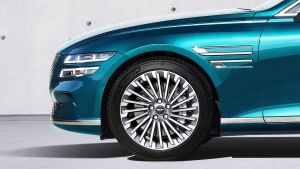
Genesis G80 EV - wheel
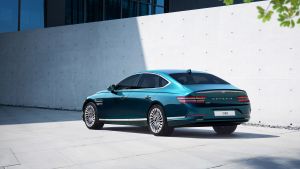
Genesis G80 EV - rear
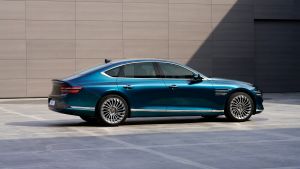
Genesis G80 EV - static profile
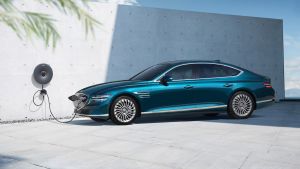
Genesis G80 EV - charging
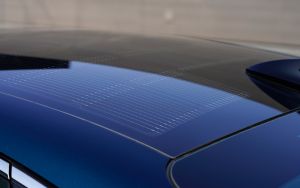
Genesis G80 EV - solar roof
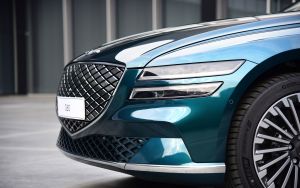
Genesis G80 EV - front-end detail
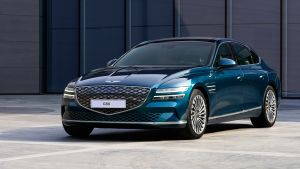
Genesis G80 EV - front
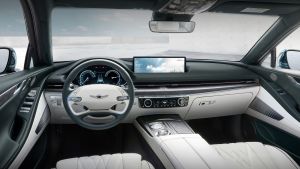
Genesis G80 EV - cabin
There’s also a solar panel mounted on the roof, which helps to top the battery up, maximising energy recovery and therefore flexibility. The car will be available in a new Matira Blue paint finish, which is exclusive to the Electrified G80.
Inside, the Genesis features plenty of recycled and sustainable materials. The dye for the leather upholstery is made using natural processes, while the interior fabrics are spun from recycled plastics. The trim on the dashboard is also constructed using recycled wood, reclaimed from furniture manufacturing processes.
Like the combustion-engined G80, the EV’s dashboard features a digital instrument cluster and an ultra-wide 14.5-inch infotainment system, which is controlled by a rotary dial on the centre console. The car’s unusual four-pronged steering wheel has also been retained.
Now read all the latest information on Genesis’s upcoming GV60 SUV, which will soon make its way onto European roads…
Continue reading...
The Electrified G80 EV forms a key part of Genesis’s push into the Chinese market, where the firm hopes to take advantage of the country’s love of large executive saloons. But, although unconfirmed, there’s also potential that the new all-electric model could make it to the UK following the Genesis brand’s launch in Europe later this year.
Genesis hasn’t followed rivals such as Tesla with its flagship saloon, however. Instead of chasing enormous power figures, the brand has focussed on comfort and driveability, so the G80 EV features an electric motor on each axle, which deliver a comparatively modest combined output of 365bhp and 700Nm of torque.
- SEE MORE Best electric cars to buy 2021
The EV’s battery capacity is yet to be confirmed, but Genesis has said the saloon can cover “up to 500km” (around 310 miles) on the NEDC test programme between charges. Genesis says this range figure was achieved by swapping some of the standard saloon’s body panels for lighter carbon fibre reinforced plastic and aluminium replacements. Reducing weight helps improve efficiency and therefore range.
Like the Hyundai Ioniq 5 and Kia EV6, The Genesis Electrified G80’s platform uses the Group’s 800V charging technology. Charge times are also yet to be confirmed but, if the G80’s system is identical to its cheaper siblings, its battery should be able to charge from 10 to 80 per cent capacity in just 18 minutes thanks to 220kW rapid charge capability.
Genesis also says the G80 EV’s electric system has a vehicle-to-load (V2L) feature, which allows the owner to use the electricity in the car’s battery to power their homes. The system has an output of 3.6kW.
The Electrified G80 looks pretty much identical to its combustion-engined sibling, although Genesis has made a few minor cosmetic tweaks which mark it out as the electric variant.
As it’s no longer required for cooling, the petrol car’s mesh radiator grille has been replaced by a blanking plate which bears the brand’s trademark “G-Matrix” pattern. The EV’s charging port is hidden in the upper right-hand corner of the new grille.

Genesis G80 EV - front detail

Genesis G80 EV - wheel

Genesis G80 EV - rear

Genesis G80 EV - static profile

Genesis G80 EV - charging

Genesis G80 EV - solar roof

Genesis G80 EV - front-end detail

Genesis G80 EV - front

Genesis G80 EV - cabin
There’s also a solar panel mounted on the roof, which helps to top the battery up, maximising energy recovery and therefore flexibility. The car will be available in a new Matira Blue paint finish, which is exclusive to the Electrified G80.
Inside, the Genesis features plenty of recycled and sustainable materials. The dye for the leather upholstery is made using natural processes, while the interior fabrics are spun from recycled plastics. The trim on the dashboard is also constructed using recycled wood, reclaimed from furniture manufacturing processes.
Like the combustion-engined G80, the EV’s dashboard features a digital instrument cluster and an ultra-wide 14.5-inch infotainment system, which is controlled by a rotary dial on the centre console. The car’s unusual four-pronged steering wheel has also been retained.
Now read all the latest information on Genesis’s upcoming GV60 SUV, which will soon make its way onto European roads…
Continue reading...
